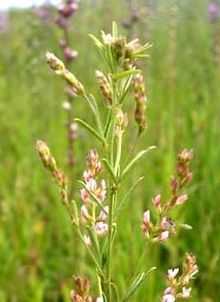Lespedeza leptostachya
| Lespedeza leptostachya | |
|---|---|
 | |
| Conservation status | |
| Scientific classification | |
| Kingdom: | Plantae |
| (unranked): | Angiosperms |
| (unranked): | Eudicots |
| (unranked): | Rosids |
| Order: | Fabales |
| Family: | Fabaceae |
| Subfamily: | Faboideae |
| Tribe: | Desmodieae |
| Subtribe: | Lespedezinae |
| Genus: | Lespedeza |
| Species: | L. leptostachya |
| Binomial name | |
| Lespedeza leptostachya Engelm. | |
Lespedeza leptostachya is a rare species of flowering plant in the legume family known by the common names prairie lespedeza and prairie bush-clover. It is endemic to the Upper Midwest region of the United States, where it occurs in the Upper Mississippi Valley in the states of Minnesota, Iowa, Wisconsin, and Illinois.[1] Most occurrences are in northern Iowa and southern Minnesota,[2] and it is rare across its known range.[1] It is federally listed as a threatened species of the US.
This is a perennial herb growing up to a meter tall. The leaves are compound, each made up of three leaflets. The herbage is coated in whitish hairs, giving the plant a silvery look. The inflorescence is a terminal spike of cream to yellowish or pale pink flowers. Each flower is only half a centimeter long. There are both cleistogamous flowers which never open, and chasmogamous flowers which open and allow insects inside; both types produce seed. Blooming occurs in July through September, with peak bloom in mid-July.[1][2] The plant does not produce flowers until its maturity at the age of 6 to 9 years.[2] The fruit is a legume pod. One plant can produce over 500 pods, however, many of them contain no viable seeds.[3]
This plant grows only in the tallgrass prairie, mainly in dry areas. The soils may be gravelly, sandy, and/or calcareous, and are generally well-drained.[1] Other plants in the area include big bluestem (Andropogon gerardi), little bluestem (Schizachyrium scoparium), yellow Indian grass (Sorghastrum nutans), side-oats grama (Bouteloua curtipendula), prairie dropseed (Sporobolus heterolepis), porcupine grass (Stipa spartea), Penn sedge (Carex pennsylvanica), copper-shouldered sedge (Carex bicknellii), sand-bracted sedge (Carex muhlenbergii), flowering spurge (Euphorbia corollata), prairie phlox (Phlox pilosa), lead plant (Amorpha canescens), rough blazing star (Liatris aspera), purple prairie clover (Dalea purpurea), showy goldenrod (Solidago speciosa), grass-leaved goldenrod (S. graminifolia), prairie gentian (Gentiana puberulenta), hoary puccoon (Lithospermum canescens), blue-eyed grass (Sisyrinchium albidum), cream wild indigo (Baptisia leucophaea), flax-leaved aster (Ionactis linariifolius), silky aster (Symphyotrichum sericeum), pale prairie coneflower (Echinacea pallida), milkwort (Polygona polygama), prairie violet (Viola pedatifida), and bird's foot violet (Viola pedata).[1][2] It can be found alongside its relative, Lespedeza capitata, and it has been known to hybridize with it,[1] though this is rare.[2]
There are 32[1] to 36[2] occurrences of the plant remaining in widely scattered locations, and most populations are small, containing fewer than 150 individuals.[1] There are many more historical occurrences which no longer exist.[1] The plant is threatened by the loss and degradation of its prairie habitat. Much of it has been consumed for development and converted to agriculture. The prevention of agents of natural disturbance, such as wildfire and the grazing of wild ungulates, has allowed ecological succession to occur, turning native prairie to shrubland.[1] The plant does not compete well with woody shrubs.[3] The plant can tolerate an amount of disturbance, and probably requires it; it was likely adapted to a landscape regularly trampled and grazed by bison.[2]
Other threats include quarry mining, herbicides and surface runoff, mowing, and weeds.[1] Heavy herbivory by insects and small mammals has been observed on the plants, including invasion of the pods by beetles.[3] The plant does not reproduce until at least its sixth year, and when it does reproduce, it usually self-fertilizes, contributing to a low genetic diversity in populations.[2]
The plant has been reintroduced at one site in Iowa.[3] As the plant probably benefited from the presence of bison, researchers are putting cattle on one site to test the effects of their grazing.[4]
References
- ↑ 1.0 1.1 1.2 1.3 1.4 1.5 1.6 1.7 1.8 1.9 1.10 Lespedeza leptostachya. The Nature Conservancy.
- ↑ 2.0 2.1 2.2 2.3 2.4 2.5 2.6 2.7 Lespedeza leptostachya. Center for Plant Conservation.
- ↑ 3.0 3.1 3.2 3.3 USFWS. http://ecos.fws.gov/docs/recovery_plan/881006.pdf Prairie Bush Clover Recovery Plan. October 1988.
- ↑ L. leptostachya. Chicago Botanic Garden.
External links
- USDA Plants Profile
- USFWS. Lespedeza leptostachya. Spotlight Species Action Plan.
